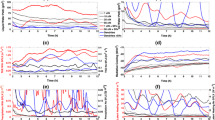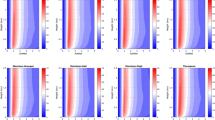Summary
A three-dimensional cloud model derived from the Klemp-Wilhelmson model has been used to perform simulations of a right-moving supercell with the purpose of testing the effects of terminal velocity of precipitation on the storm dynamics. The model has no ice variables and computes a fall velocity for condensed water. We simulate one of the effects of ice presence, without including phase transition, by reducing the fall velocity of the precipitation in the coldest cloud layers. The reduction of precipitation terminal velocity is shown to have a strong influence on supercell dynamics and to be responsible for nearly all the improvements in the simulation of supercells that are obtained with full ice microphysics. This includes the transition to tornadic phase, which is sharper than in the case of a pure rain supercell. The vertical component of vorticity is seen to increase at all levels, as observed in real storms, instead of just at the surface as is common in simulations with no ice phase.
Our results indicate the primary importance of terminal fall speed among the effects due to the presence of ice.
Similar content being viewed by others
References
Brandes, E. A., 1981: Fine structure of the Del City-Edmond tornadic mesocirculation.Mon. Wea. Rev.,109, 635–647.
Brandes, E. A., 1984a: Relationships between radar-derived thermodynamic variables and tornadogenesis.Mon. Wea. Rev.,112, 1033–1052.
Brandes, E. A., 1984b: Vertical velocity generation and mesocyclone sustenance in tornadic thunderstorms: the observational evidence.Mon. Wea. Rev.,112, 2253–2269.
Farley, R. D., Orville, H. D., 1986: Numerical modeling of hailstorms and hailstone growth. Part I: Preliminary model verification and sensitivity tests.J. Climate Appl. Meteor.,25, 2014–2036.
Johnson, D. E., Wang, P. K., Straka, J. M., 1993: Numerical simulations of the 2 August 1981 CCOPE supercell storm with and without ice microphysics.J. Appl. Meteor.,32, 745–758.
Kessler, E., III, 1969: On the distribution and continuity of water substance in atmospheric circulation.Meteorol. Monogr., No.32, Amer. Meteor. Soc., 84 pp.
Klemp, J. B., Rotunno, R. 1983: A study of the tornadic region within a supercell thunderstorm.J. Atmos. Sci.,40, 359–377.
Klemp, J. B., Wilhelmson, R. B., 1978: The simulation of three-dimensional convective storm dynamics.J. Atmos. Sci.,35, 1070–1096.
Klemp, J. B., Wilhelmson, R. B., Ray, P. S., 1981: Observed and numerically simulated structure of a mature supercell thunderstorm.J. Atmos. Sci.,38, 1558–1580.
Lemon, L. R., Doswell III, C. A., 1979: Severe thunderstorm evolution and mesocyclone structure as related to tornadogenesis.Mon. Wea. Rev.,95, 509–530.
Lin, Y. L., Farley, R. D., Orville, H. D., 1983: Bulk parameterization of the snow field in a cloud model.J. Climate Appl. Meteor.,22, 1065–1092.
Orville, H. D., 1980: Numerical modeling of clouds. In “Lecture notes IFAORS Short Course 450 on Clouds: Their Formation, Properties and Effects.” Williamsburg, Virginia, December 1–5, 1980. Held at the Institute for Atmospheric Optics and Remote Sensing. Available from Post Office P. Hanyston, Virginia. 23666.
Ray, P. S., Johnson, B. C., Johnson, K. W., Bradberry, J. S., Sthephens, J. J., Wagner, K. K., Wilhelmson, R. B., Klemp, J. B., 1981: The morphology of several tornadic storms on 20 May 1977.J. Atmos. Sci.,38, 1643–1663.
Rotunno, R., Klemp, J. B., 1985: On the rotation and propagation of simulated supercell thunderstorms.J. Atmos. Sci.,42, 271–292.
Schlesinger, R. E., 1978: A three-dimensional numerical model of an isolated thunderstorm. Part I: Comparative experiments for variable ambient wind shear.J. Atmos. Sci.,35, 1643–1663.
Weisman, M. L., Klemp, J. B., 1982: The dependence of numerically simulated convective storms on vertical wind shear and buoyancy.Mon. Wea. Rev.,110, 504–520.
Weisman, M. L., Klemp, J. B., 1984: The structure and classification of numerically simulated convective storms in directionally varying wind shears.Mon. Wea. Rev.,112, 2479–2498.
Author information
Authors and Affiliations
Additional information
With 13 Figures
Rights and permissions
About this article
Cite this article
Tartaglione, N., Buzzi, A. & Fantini, M. Supercell simulations with simple ice parameterization. Meteorl. Atmos. Phys. 58, 139–149 (1996). https://doi.org/10.1007/BF01027561
Received:
Revised:
Published:
Issue Date:
DOI: https://doi.org/10.1007/BF01027561




